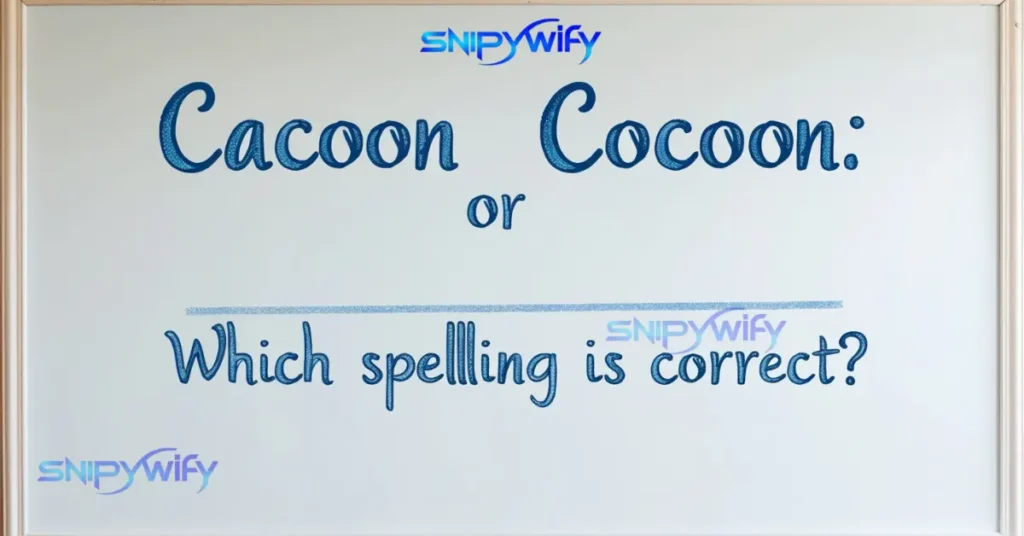Have you ever typed “cacoon” instead of “cocoon” and wondered which is correct? The correct spelling is cocoon. While “cacoon” often appears in informal writing, it is a misspelling. This confusion arises due to how the word sounds when spoken.
A cocoon is a protective casing created by certain insects, like caterpillars, during their metamorphosis stage. It also symbolizes personal transformation or growth. Let’s explore the differences between the two spellings and uncover their meanings, usage, and origins.
Why is There Confusion?
The word “cacoon” looks correct because it matches how people pronounce the word in some regions. This typo error is common when English learners or writers rely on phonetics.
Autocorrect tools sometimes miss the mistake, leaving incorrect spelling unchecked. But learning the correct spelling cocoon is crucial for writing clarity and avoiding such common errors.
What is a “Cacoon”?
A “cacoon” is not an official English word. It is a spelling mistake caused by mishearing the correct word.
In some contexts, people mistakenly associate “cacoon” with plants, like the snuffbox bean plant. However, this usage is inaccurate since no plant officially carries this name.
What is a “Cocoon”?
A cocoon is an insect shell made of silk or other fibers. It protects larvae during their metamorphosis process. Scientifically, it refers to the pupal stage in species like moths and butterflies.
Metaphorically, a cocoon represents a sheltered space or a stage of personal growth and rebirth. It also inspires designs, such as the cozy cocoon chair and other interior aesthetics in modern furniture.
“Cacoon” vs “Cocoon”: The Differences
Spelling:
- Cocoon spelling is correct and follows English grammar rules.
- “Cacoon” is a typo error and lacks official recognition.
Meaning:
- Cocoon refers to a protective casing, symbolizing transformation.
- “Cacoon” has no defined meaning in the English language.
Usage:
- Use cocoon when discussing insect metamorphosis or personal transformation.
- Avoid using “cacoon”, as it reflects poor word accuracy.
Examples of “Cacoon” and “Cocoon” in Context
“Cacoon” in Context:
- Incorrect: “The caterpillar weaves a silk cacoon.”
- Corrected: “The caterpillar weaves a silk cocoon.”
Cocoon in Context:
- “The butterfly emerged from its protective cocoon.”
- “She created a sheltered space, a metaphorical cocoon, to focus on self-improvement.”
Origins of “Cacoon” and “Cocoon”
Origins of “Cacoon”
The word likely stems from a misspelling or regional pronunciation. Over time, it has spread in informal writing due to phonetics.
Origins of “Cocoon”
The term cocoon derives from the French word cocon, meaning “silk casing.” It traces back to Latin roots and describes the enclosing structure used by insects for protection.
Read More>>> 90+ Thank You for the Quick Response Messages
Frequently Asked Questions
What is a Cacoon?
A cacoon is an incorrect spelling of the word cocoon. It has no official meaning in English.
What is the correct spelling of cocoon?
The correct spelling is cocoon, referring to a protective casing made by insects like caterpillars.
How do you spell cocoon for a butterfly?
The correct spelling is cocoon, which is used to describe the silk structure a butterfly uses during its metamorphosis.
What is a cocoon in English?
In English, a cocoon is a silk casing created by insects to protect themselves during their pupal stage.
Conclusion
The correct spelling is “cocoon,” while “cacoon” is a common misspelling. A cocoon refers to a protective casing created during an insect’s metamorphosis and symbolizes transformation and growth in metaphorical contexts.
Whether discussing insect shells, modern furniture like a cocoon chair, or personal transformation, always use the proper term. Avoid the incorrect spelling to ensure clarity and maintain writing accuracy. Understanding the differences between “cacoon” and “cocoon” can improve your English proficiency and boost your communication skills.
